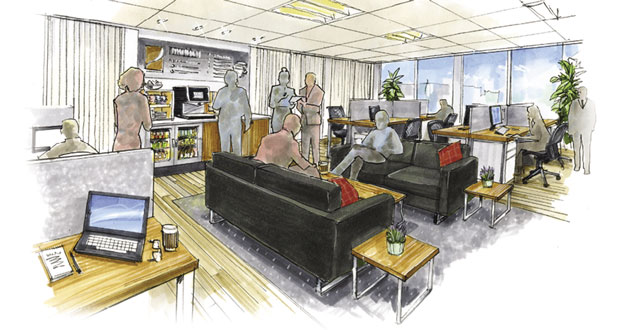 David Basson, Head of Beverages at Nestlé Professional shares the results of research on the role of coffee breaks in workplace productivity and offers tips on making the most of opportunities to connect
David Basson, Head of Beverages at Nestlé Professional shares the results of research on the role of coffee breaks in workplace productivity and offers tips on making the most of opportunities to connect
Whatever the reason for hybrid working there remains a desire to be in a physical office space. Recent Nestlé Coffee Partners research revealed that for 68 per cent of employees, the office is still critical to their productivity – with 39 per cent saying they feel more productive in the workplace and 29 per cent preferring a mix of workplace and home. But while many believe offices are now purely a place for collaboration and engagement, the research also revealed that almost a quarter (23 per cent) of employees say they are more productive there because of the peace and quiet and 24 per cent because of fewer distractions.
Face-to-face collaboration and communication remain important. Of the employees who feel more productive at work, 44 per cent say this is down to interacting with colleagues, 33 per cent say it’s the social aspect and collaborating with a team, and 26 per cent put it down to an inspiring atmosphere. This has important implications when it comes to workplace design, giving facilities managers food for thought when adapting spaces to meet diverse workforce needs.
SMART COFFEE BREAKS
Nestlé Coffee Partners has been discussing these findings on employee attitudes towards the workplace with world-leading experts in ‘Smart Coffee Break – The Productivity Podcast’, gathering perspectives and advice from productivity expert, Despina Katsikakis, Neuroscientist and Flow-Specialist, Dr Fiona Kerr, alongside other eminent figures in the field. Adding insight from their expertise, they’ve developed a series of pointers on creating workplaces that both inspire and refresh. Some of these pointers are about the placement of interactive points in the office or the provision of workplace beverages.
As Despina Katsikakis states: “Organisations need to adapt to how people will work differently, to align the space to those new behaviours, and to focus on creating dynamic ways to reinforce those elements of serendipity, of occasion, of memorable and delightful experiences.”
To address this, we recommend designing office space around behavioural outcomes. Falling within four categories: individual flow and focus, optimised teamwork, team-to-team and in-team collaboration, and unplanned interaction; each requires different environmental considerations to ensure success and productivity. And with seven out of 10 employees saying they have better work ideas and are more productive after a coffee, it also helps to identify the optimum placement for beverage points in each of these environments.
PROMOTING INTERACTIONS
Carefully placed hot beverages play a valuable role as a powerful attractor, creating moments of planned and unplanned interactions in the workplace.
In fact, encouraging movement through the office doesn’t just give employees a chance to refresh and regroup; it boosts productivity. And according to Dr Fiona Kerr, this also enhances flow: “When you look out the window or go for a walk it’s a key part of flow – it allows your brain to relax, so it can pick out bits you want to focus on and put it all together.”
Employees with clear goals that require individual flow and focus need distraction-free working spaces with minimal noise. For these, hot beverage solutions should stage ‘strategic interventions’, rather than ‘unplanned interruptions’, so they can optimise outputs and avoid setbacks in flow-state productivity.
To achieve this, hot beverage points should be strategically placed at the end of each row of desks – out of reach from other teams to prevent noisy gatherings. This close proximity to desks prevents the need for those in focus to leave their area and risk interrupting their state of flow.
Optimised teamwork and cohesion require face-to-face team contact away from outside distractions. In this context, hot beverages play a key role, encouraging impactful and efficient group meetings and discussions across the team.
Productive behaviour and better time management can be facilitated through providing a hot beverage point in the meeting room. A centralised hot beverage point in a communal space outside but in close proximity to the meeting room will also ensure more efficient breaks and encourage the continuation of conversations beyond the meeting room. Prevent input from external sources by locating the point in a space where only the chosen group or team can use it and connect.
Where team-to-team and in-team collaboration are required, goals are less defined, leading input from outside influences to support cross pollination of ideas.
Hot beverages are ideal for staging productive interactions between teams who don’t normally communicate with one another or have limited time for breaks. A centralised hot beverage point at the centre of spaces where teams/departments cross or meet facilitates collaboration. Be mindful that employees should be able to choose when to break away. This is where a kitchen space provides the perfect opportunity for individual space, rest and recuperation when needed.
Unplanned connections build trust, spark new ideas and promote different ways of thinking. Here is where the workplace café plays a critical role, offering employees a relaxed environment for socialising, collaboration, and refreshment. In this context, colleagues may find themselves interacting in a way that’s less formal, and through allowing them to chat naturally, it is likely to breed unplanned interactions, leading to those all-important ‘light bulb’ moments.
View the insights here – https://bit.ly/3qmM7za





